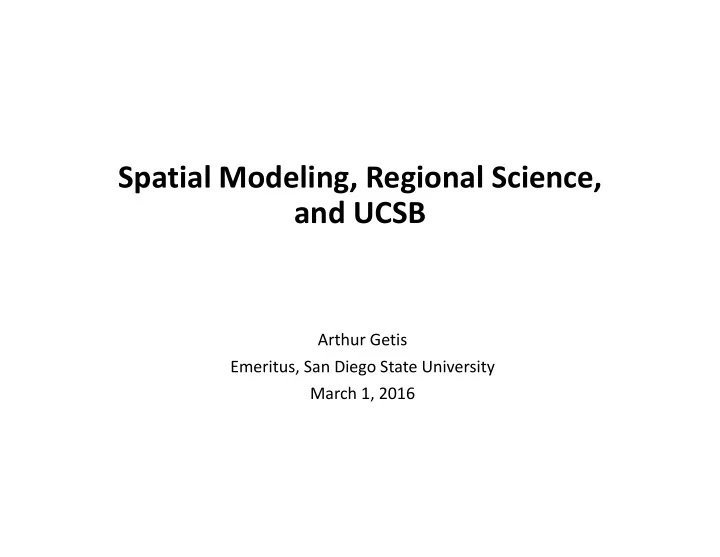

Spatial Modeling, Regional Science, and UCSB Arthur Getis Emeritus, San Diego State University March 1, 2016
My Link to UCSB • The 1980s at UCSB (summers and sabbatical) • Problems within Geography: “The Quantitative Revolution” • Attraction to Regional Science • Directed joint SDSU ‐ UCSB Ph.D. program in the 1990s • Participated in Goodchild’s workshops and other NCGIA activities • Participated in Janelle’s CSISS workshops
Who Identified (more or less) with Regional Science at UCSB in the 1980s • Luc Anselin • Richard Church • Helen Couclelis • Reg Golledge • Mike Goodchild • Terry Smith • Bob Stimson (visitor) • Waldo Tobler
The Creation of Regional Science • Isard and the perceived failings of economics • The Geographers role: Ullman, Garrison, Hagerstrand and their UW students • Berry, Tobler, Nystuen, Marble, Dacey, Bunge, Morrill, Getis at Chicago, Michigan, Michigan, Penn, Northwestern, Wayne State, Washington, and Michigan State, respectively
Waldo Tobler
Luc Anselin
Richard Church
Reginald Golledge
Michael Goodchild
Helen Couclelis
The Growth of Regional Science Disaffected geographers, economic geographers • “Disproved” theories (CPT) in geography, driven to RS • The decline of urban planning • The regional economists—Kuznetz • The role of economists studying developing countries • The role of statistical spatial autocorrelation and modeling •
Regional Science and Quantitative Geographers: Common Elements • Spatial Modeling, Use of Spatial Parameters • Spatial Behavior and Mapping • Urban and Economic Modeling, Operations Research • Spatial Econometrics
Regional Science Association International • 7,000+ Members • Tree Organizational Structure • Three Continental Divisions (NARSC, ERSA, PRSCO) • Many Regional Associations (e.g., within NARSC, there is WRSA, MCRSA, NERSA, SRSA, BRSA)
The Field of Regional Science • Analytical approaches to problems specifically urban, rural, and regional • Location theory including: • location modeling, transportation, migration, land use, urban development, interindustry analysis, environmental and ecological analysis resource management, urban and regional policy analysis, geographical information systems, spatial data analysis. • From Wikipedia: “. . . any social science analysis that has a spatial dimension . . .”
Journals Journals
Notable Events • The “Discovery” of Spatial Autocorrelation • “Intellectualizing Bells and Whistles”: The GIS Revolution • The solution to the Transportation Problem • Testing Christaller and L ӧ sch (the development of probability models) • The arrival of Interregional Input ‐ Output Analysis • Industrial spatial cluster analysis • Local statistics • Changing from small data to large data problems • Addressing the convergence problem spatially • Development of spatial econometrics
Typology of Spatial Econometric Models: The Influence of Anselin • General Model: Y = W 1 Y + X + = W 2 + with normal, 0 mean, and constant variance (i.e., variance is the same for every variable and covariance for every combination of variables is always 0)
Ty Typology of of Spa Spatial ial Ec Econometric Mo Mode dels Y = W 1 Y + X + and = W 2 + set =0, = 0 ‐‐‐‐‐‐ RESULT is Y = X + [NON ‐ SPATIAL; linear regression model] set = 0 ‐‐‐‐‐‐‐ RESULT is Y = W 1 Y + X + [spatial lag model] set =0 ‐‐‐‐‐‐‐ RESULT is Y = X + (I ‐ W 2 ) ‐ 1 [spatial disturbance model] also ‐‐‐‐‐‐‐ Y = W 1 Y + X + (I ‐ W 2 ) ‐ 1 [spatial Durbin model]
Spatial Econometric Models (continued) • Also, vary variance and covariance assumptions. ( can represent heteroscedasticity as well as homoscedasticity) • Also, can include time (create space ‐ time models) • And, on and on, with contributions by spatial thinkers among others: Le Sage, Paelinck, Kelejian, Rey, Murray, Fotheringham, O’Kelly, Griffith, Church, Ord and Getis
Testing the Models • In any model, if error term is correlated, OLS is inappropriate device to find parameters. Usual tests on parameters and R 2 cannot be used. • Use maximum likelihood approach (i.e., the parameters most likely to give you your data). • Bayesian approaches Wald test on parameters; Likelihood Ratio test on the goodness of the model; La Grange Multiplier test on residuals (non ‐ spatial); Moran’s I test on residuals (spatial)
Geographers Contributions to Regional Science Perspectives • Scale (statistics that vary d —LISA, G, K, ESDA, multiple scales) • Zoning (use smallest units and then aggregate upward if necessary; use statistics that vary d ; ESDA, multiple zonings, Fotheringham and Wong) • Dependence (Global, Local, SpaStats, Geoda, Variogram, Spa. Econ., Anselin and others) • Heterogeneity (statistics that vary d , GWR, partitioning) • Filtering (Griffith eigenvectors, Getis spatial autocorrelation) • Boundaries (NN, Ripley’s K function) • Missing Data (geostatistics, Kyriakidis, Griffith) • L arge Data Sets (nearly all of the above, partitioning, redundancy)
Role of Technology: The GIS Revolution • Simulation • Visualization of Data • Mapping visualization • Filtering • Variable combinations • Data Description • The Big Data Problem • Heterogeneity and Dependence
Trends in Regional Science, Modeling, and Geography • Regional Science: Asian spatial problems fill journals, environmental issues, rapid development of field • Modeling: Advances in software, more sophisticated modeling, GIS • Geography: Spatial approaches holding on for dear life—pushed out to the periphery, strong physical and environmental contributions, economic geography nearly non ‐ existent, GIS central and building
Recommend
More recommend